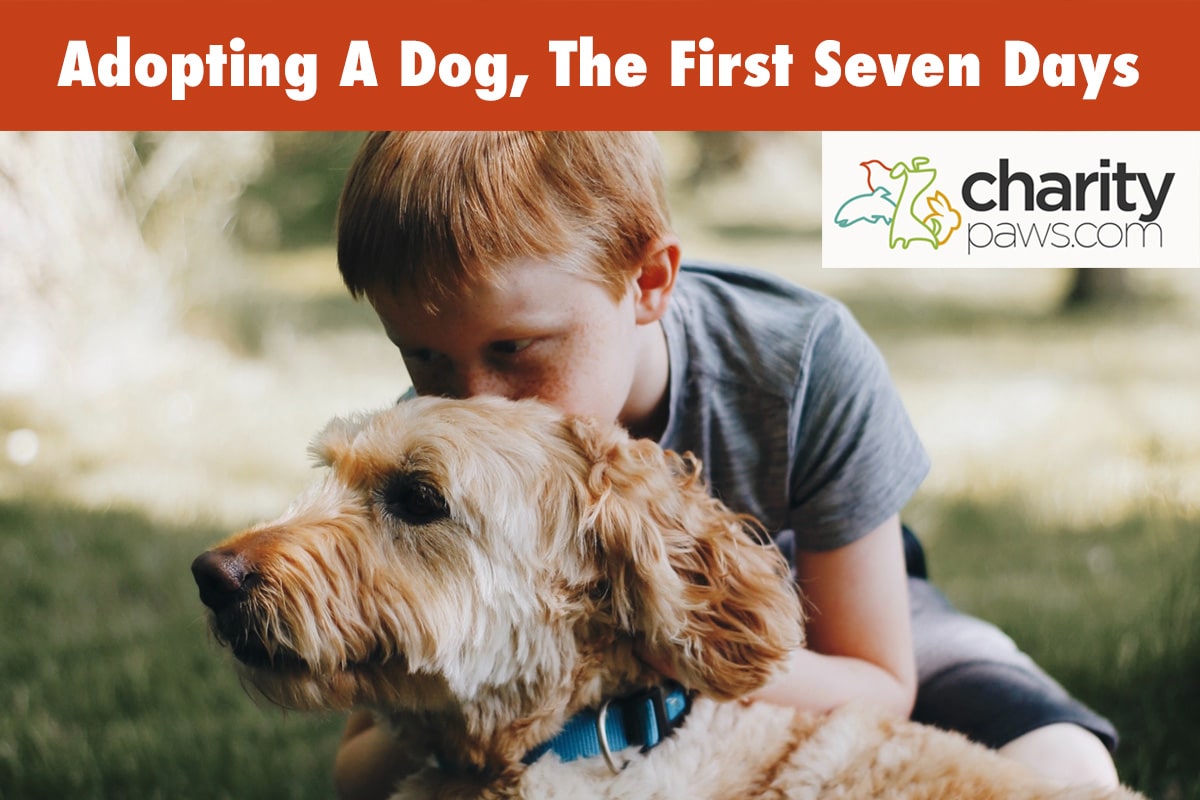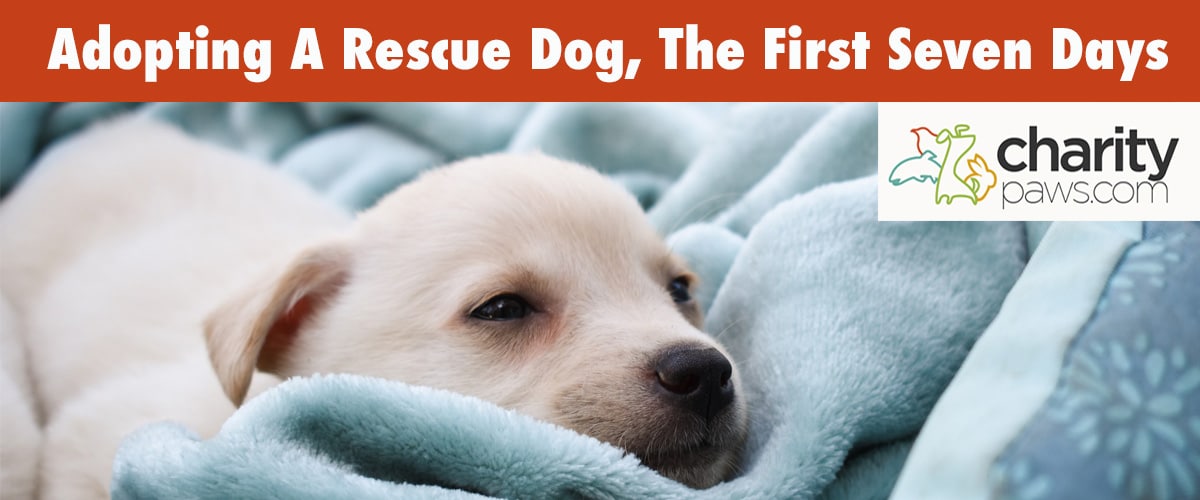Welcoming a rescue dog into your home is an incredible experience.
These pups have so much love to give, and adopting a rescue will ensure an amazing companion to come.
While this is an exciting time that you should certainly look forward to, there are many ways in which you need to prepare.
By understanding what to expect during your first week together, you can ensure a smooth transition for your rescued canine friend.
Let’s discuss a day by day guide on how to care for your adopted pup, and some of the best ways that you can help them adjust to being in your home.

What Should I Know About Adopting A Rescue Dog?
The choice of adoption is always an incredible one.
These pups deserve a loving family like yours, and they will reward you tenfold with love and companionship.
Find A Local Dog Rescue To Adopt From
While the experience of adopting a rescue dog will always be worth any struggles and adjustments along the way, there are a few things you should expect and understand from the start.
First, you should always understand that no matter how amazing of a home you are offering, it will still be an adjustment for your rescue dog.
These pups often come from an unstable past before they made it to the shelter or rescue, and this can make it hard for them to immediately trust in their new family.
It takes 3 days for a rescue dog to no longer be afraid of their new home, 3 weeks for them to finally feel comfortable in their new home, and 3 months for their true personality to shine.
You should also expect to practice patience and understanding with your rescue dog until they get used to being a part of your family.
This means being patient about their potty training, sleep schedule, barking, triggers, and any other bumps in the road that come along.
They will adjust, but it will take time.
If you are choosing to adopt a canine friend from a rescue or shelter, we already know that you have the patience and understanding to care for these incredible pups.
Now, let’s go into the best ways to prepare for their arrival, and what you can expect for the first 7 days.
How To Prepare For Your New Rescue Dog
Before you welcome your new canine friend into your home, there are a few ways in which you should prepare.
Ranging from having dog supplies to an introduction plan in place, let’s list a few of the best ways to prepare.
Find A Veterinarian
Make sure you find a veterinarian ahead of time, as it could take weeks to get them seen once you adopt them.
Clinics are booked out 1-2 months in advance for new patients, so finding a vet and setting an appointment the moment you agree to adoption will decrease any waiting periods.
Dog Proof Your Home
Make sure your home is dog proof.
This means making sure all trash is secured, removing poisonous plants, covering any dangerous wires, securing any cleaning supplies or chemicals, and removing any other items that could be dangerous.
Stock Up On Dog Supplies
You will want to have a leash and collar, food and water bowls, a cozy dog bed, toys, treats, and a veterinary approved diet.
Have An Introduction Plan For Other Pets In The Home
Develop an introduction plan if you have any other pets in the home.
You will want to keep them separate for the first week they are in your home to allow for proper adjustment, then slowly begin to introduce the furry friends.
A typical introduction process typically involves:
- Initial separation
- Sniffing each other through a door
- Meeting through a gate
- Interacting on a leash
- and finally interacting freely
Every timeline will vary, so always allow your animals to take their time.
The First Seven Days With Your Rescue Dog
Now that you are all prepared for your rescue dog’s arrival, it’s time to enjoy your first week together.
Let’s break it down from day 1 to 7 on what to expect during your first week with a rescue dog.
Day 1
On day one of bringing your rescue dog home, there should be no major expectations.
You should simply allow your new pup to explore their new surroundings at their own pace, and show them that you will not force any interactions or experiences.
By doing this, you will be setting a sturdy foundation for the week to come.
If your rescue dog is especially nervous, they may do well with only having one room to explore.
Having an entire home to explore can be scary for some dogs, so confining them to one small space may allow them to calm their nerves during the first 24 hours in your home.
If you do offer your rescue dog any new snacks or toys, be sure to set them on the ground if they are too afraid to grab them from you.
Once they learn that you can be trusted, they will feel more comfortable with taking treats out of your hand.
Day 2
Your rescue dog will still be getting used to your home on day 2, but they may feel a bit more comfortable after their first night.
You may notice them exploring more and more of the house when given the chance, and some may even welcome interactions with you and other members of the home.
While this is wonderful, you should still remember to give your dog as much space as they need.
Having a calm and quiet home is essential for these first few days, so simply relaxing and allowing them to explore is always best.
By day 2, you should also begin to implement some structure that you will follow moving forward.
This means establishing meal times, potty breaks, walks, and any other routines you may want to implement.
Your pup may not catch on immediately, but it’s a good idea to start now.
Dogs thrive on a structured routine, so this can even help them settle into their new life.
Day 3
By day 3, you will notice that your rescue dog is much less fearful of their new environment.
Their nerves have likely settled enough to let their guard down, so they will begin to feel a lot more comfortable with you and your home.
You may notice your rescue dog being eager to be next to you, go on walks, eat treats, and explore their new surroundings.
You really want to focus on building trust at this point, so we encourage you to spend as much time with your new pup as possible.
Now that they know they are not in danger in your home, you will want to encourage bonding as much as possible.
Simple things like going on walks, playing fetch, and welcomed cuddle sessions will go a long way.
Also be sure that you are sticking to your established routine.
They will be more receptive to this structure now that they are not so afraid, so these rules will really begin to stick.
Day 4
Not much will change from day 3 to 4, but you will notice your new rescue dog getting more and more comfortable as each day passes.
While you will begin to bond with your pup and start making memories, you may also begin to notice a few bad habits.
If this is the case, it’s important to refrain from any negative reinforcement, as this is a crucial time for your pup to feel safe with you.
Any bad habits should be addressed with basic obedience training (if they know any), positive reinforcement for good behavior, and plenty of patience.
You wont fix these issues overnight, but you can help your pup understand that they do not have to fear you if they do something wrong.
Also keep in mind that your adopted dog is still learning the ropes, so try not to be too hard on them for things like potty training issues or crying at night.
They will grasp these concepts soon.
Day 5
When day 5 rolls around, your pup should be well integrated into the family.
They are typically comfortable in the home, at your side, and even catching on to some of your routines.
You may even feel comfortable enough to take your new rescue pup on new adventures, whether this is on a long walk in your neighborhood or your favorite spot at the park.
Your pup should also be acclimated enough to have them assessed by a veterinarian at this point.
Most rescue dogs will be fully vaccinated and vetted at the time of adoption, but it is still important to have them assessed by your veterinarian of choice.
This not only establishes a veterinary relationship for the future, but it can also spot any underlying conditions that could have been missing in a shelter setting.
Day 6
Similar to day 5, you can typically begin to explore more of the world with your new rescue dog.
You are starting to really get to know each other and what your pup enjoys, as well as any triggers they may encounter along the way.
By taking note of these things as you see them, you can better help your pup address these issues in the near future.
Day 7
As you wrap up your first week with your beloved rescue dog, the two of you will be on the way to building a beautiful friendship moving forward.
At this point you may have a general idea of what they enjoy, what scares them, and any behavioral issues they may struggle with.
You can then confront these issues as the weeks go on, especially now that your rescue dog understands that they can trust you.
If you do have any other pets in your home, you can typically begin the process of introducing them at this point.
Just be sure to follow recommended socialization rules, as simply putting them together can be extremely dangerous.
Just remember that every dog is different, so you will need to cater your introduction plan to fit your pet’s needs.
Moving Forward With Your New Rescue Pup

As we mentioned above, it can still take up to 3 months for your rescue dog’s true personality to shine.
As long as you continue to strengthen the bond between you and your pup, follow a structured routine, and address any behavioral concerns in a positive way, your rescue dog will feel comfortable with coming out of their shell.
A beautiful future lies ahead for you and your rescued pup!
Final Thoughts
Adopting a rescue dog will require patience and understanding, but you will be rewarded with a loyal and loving companion in the long run.
Be sure to take this time to really get to know your pup and show them that they are safe in your home, and it will make all the difference for your future together.

